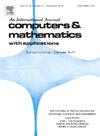可溶性表面活性剂两相流的晶格玻尔兹曼和有限差分混合方法
IF 2.9
2区 数学
Q1 MATHEMATICS, APPLIED
引用次数: 0
摘要
本文开发了一种混合方法来模拟含有可溶性表面活性剂的两相流动。在该方法中,采用有限差分法求解整个流体域中的扩散-界面形式的界面和块体表面活性剂浓度方程,其中包括考虑表面活性剂吸附和解吸动力学的源项,同时采用晶格玻尔兹曼颜色梯度模型求解两相流,该模型可精确模拟密度不等的二元流体。流动和界面表面活性剂浓度场通过修正的朗缪尔状态方程耦合,该方程允许表面活性剂浓度超过临界胶束浓度。首先通过模拟三个数值示例验证了混合方法的能力和准确性,包括静止液滴界面上的大量表面活性剂吸附、恒定表面活性剂梯度中的液滴迁移以及简单剪切流中富含表面活性剂液滴的变形。然后,应用混合方法模拟了表面活性剂溶液中由浮力驱动的气泡上升,其中确定了表面活性剂对不同壁面约束、密度比、Eotvos 数和 Biot 数的影响。研究发现,由于马兰戈尼应力阻碍了界面运动,表面活性剂对气泡的上升产生了阻滞作用,而随着 Eotvos 或 Biot 数的增加,这种阻滞作用会减弱。我们进一步研究发现,Biot 数越高,延缓效应越弱,这是因为界面上表面活性剂的非均匀效应减弱了。通过与 Cahn-Hilliard 相场方法的比较,我们还发现本方法保留了每种流体的质量,提高了数值稳定性,尤其是在高密度比和高 Eotvos 数下,并且不需要选择自由参数,从而打破了现有方法的局限性。本文章由计算机程序翻译,如有差异,请以英文原文为准。
A hybrid lattice Boltzmann and finite difference method for two-phase flows with soluble surfactants
A hybrid method is developed to simulate two-phase flows with soluble surfactants. In this method, the interface and bulk surfactant concentration equations of diffuse-interface form, which include source terms to consider surfactant adsorption and desorption dynamics, are solved in the entire fluid domain by the finite difference method, while two-phase flows are solved by a lattice Boltzmann color-gradient model, which can accurately simulate binary fluids with unequal densities. The flow and interface surfactant concentration fields are coupled by a modified Langmuir equation of state, which allows for surfactant concentration beyond critical micelle concentration. The capability and accuracy of the hybrid method are first validated by simulating three numerical examples, including the adsorption of bulk surfactants onto the interface of a stationary droplet, the droplet migration in a constant surfactant gradient, and the deformation of a surfactant-laden droplet in a simple shear flow, in which the numerical results are compared with theoretical solutions and available literature data. Then, the hybrid method is applied to simulate the buoyancy-driven bubble rise in a surfactant solution, in which the influence of surfactants is identified for varying wall confinement, density ratio, Eotvos number and Biot number. It is found that surfactants exhibit a retardation effect on the bubble rise due to the Marangoni stress that resists interface motion, and the retardation effect weakens as the Eotvos or Biot number increases. We further show that the weakened retardation effect at higher Biot numbers is attributed to a decreased non-uniform effect of surfactants at the interface. By comparing with the Cahn-Hilliard phase-field method, we also show that the present method conserves the mass for each fluid, improves numerical stability especially at high density ratio and Eotvos number, and does not need the selection of free parameters, thus breaking the limitations of the existing method.
求助全文
通过发布文献求助,成功后即可免费获取论文全文。
去求助
来源期刊

Computers & Mathematics with Applications
工程技术-计算机:跨学科应用
CiteScore
5.10
自引率
10.30%
发文量
396
审稿时长
9.9 weeks
期刊介绍:
Computers & Mathematics with Applications provides a medium of exchange for those engaged in fields contributing to building successful simulations for science and engineering using Partial Differential Equations (PDEs).
 求助内容:
求助内容: 应助结果提醒方式:
应助结果提醒方式:


